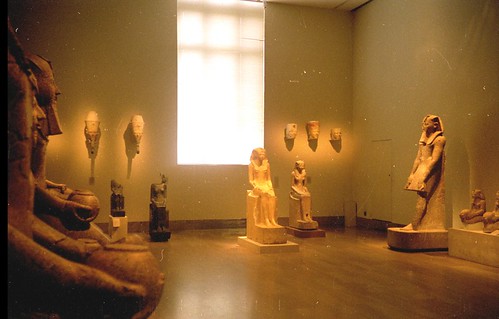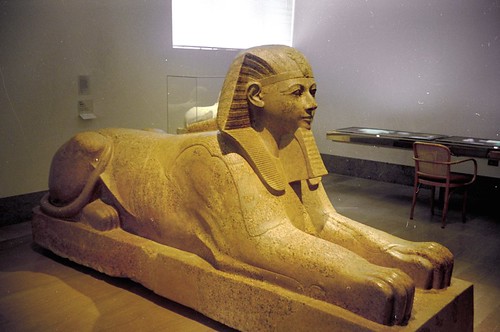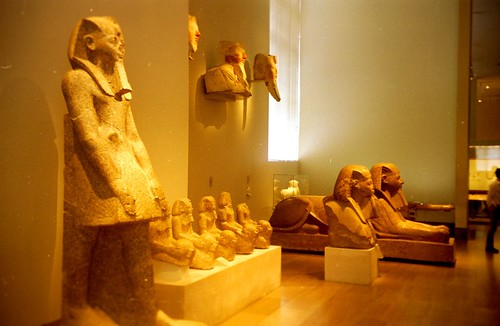Galería de Hans Ollermann
Queen Hatshepsut (1479-1458 B.C.)
2000 07 Bijna mystieke Hatsjepsut zaal in het Metropolitan Museum of Art

The almost mystic Hatsjepsut Room in the Metropolitan.
2000 06 Een drietal Hatsjepsut beelden in het Metropolitan Museum of Art, New York

Three statues of Hatsjepsut in my favourite museum: the Metropolitan Museum of Art, New York
2000 20 Sfinx van Hatsjepsut, Metropolitan Museum

Sfinx van Hatsjepsut in my favourite museum, the Metropolitan Museum of Art, New York
2004_0315_141312aa Hatsjepsut

Comentários
L'Angelo Misterioso disse:
I love her eternal smile!Postado 13 meses atrás.
2004_0831_120146AA Obelisk van Thoetmosis III, Piazza San Giovanni, Rome

03 The square in front of the Lateran Palace in Rome has the highest ancient Egyptian obelisk, that has survived 33 centuries: 32,18 m high !.
The obelisk was built by Pharaoh Thutmosis III in Karnak, and ca 2300 years later placed in the Circus Maximus before being re-erected in its current place.
King Tuthmosis III is regarded as one of the greatest pharaohs who ever reigned. He became pharao when Queen Hatsjepsut, a daughter of his father, died.
Comentários
Ray_Flynn  disse:
disse:
Hi, I'm an admin for a group called Obelisks of Rome, and we'd love to have this added to the group!2000 21

The famous Hatsjepsut Room in the Metropolitan Museum of Art, New York (2000)
Categorías
De Egiptopedia; Antiguo Egipto
Existen las siguientes categorías en este wiki.
- Aegyptíaka de Manetón 15 artículos
- Ajuar funerario 10 artículos
- Alimentación 2 artículos
- Amuletos 11 artículos
- Animales 4 artículos
- Arquitectos: constructores, inspectores de obras públicas, ingenieros 1 artículo
- Arquitectura 8 artículos
- Arte 80 artículos
- Ayuda 2 artículos
- Baja Época 1 artículo
- CC-BY-1.0 4 artículos
- CC-BY-2.5 19 artículos
- Coronas y Titulaturas Reales 4 artículos
- Cronología 7 artículos
- Dinastía I. Faraones 2 artículos
- Dinastía XX 1 artículo
- Dinastías 35 artículos
- Dinastías persas 1 artículo
- Dioses 169 artículos
- Divinidades antropomorfas femeninas 34 artículos
- Divinidades antropomorfas masculinas 23 artículos
- Divinidades funerarias 2 artículos
- Divinidades por atributos 1 artículo
- División territorial 2 artículos
- Egiptopedia:Plantillas 3 artículos
- Egiptopedia:Plantillas de 1 artículo
- Egiptopedia:Plantillas de recuadros 1 artículo
- Egiptólogos 14 artículos
- Elaboración de pan. Fotos 1 artículo
- Elementos arquitectónicos 6 artículos
- Enemigos de Egipto 5 artículos
- Escribas 1 artículo
- Escritura 9 artículos
- Escultura 48 artículos
- Escultura. Fotos 6 artículos
- Esposas Reales 3 artículos
- Estelas 18 artículos
- Estelas fronterizas de Amarna 1 artículo
- Estructuras del templo 11 artículos
- Faraones 96 artículos
- Fotos 4 artículos
- Fotos Imperio Nuevo 1 artículo
- Funcionarios 1 artículo
- Funcionarios reales y sirvientes 2 artículos
- Historiadores 1 artículo
- Imperio Nuevo 3 artículos
- Imperio Nuevo. Escultura 12 artículos
- Imperio Nuevo. Fotos escultura 11 artículos
- Imperio Nuevo. Tumbas 4 artículos
- Imperio Nuevo Tumbas. Fotos 1 artículo
- Instrumentos Musicales 4 artículos
- Joyas 19 artículos
- Libro de los Muertos 62 artículos
- Lista reales o de faraones 1 artículo
- Literatura 38 artículos
- Literatura religiosa 12 artículos
- Mastabas 4 artículos
- Mastabas. Reino Antiguo 3 artículos
- Materiales 12 artículos
- Medicina 20 artículos
- Momias 3 artículos
- Museo Nacional de Alejandría. Fotos 1 artículo
- Museos.Fotos 1 artículo
- Museos y colecciones del Antiguo Egipto en el mundo 36 artículos
- Música 5 artículos
- Necrópolis 6 artículos
- Nobles y cortesanos 1 artículo
- Nomarcas y gobernadores 1 artículo
- Nomos 3 artículos
- Oficios. Fotos 1 artículo
- Papiros 2 artículos
- Periodo Arcaico 1 artículo
- Periodo Predinástico. Fotos escultura 1 artículo
- Periodo Protodinástico 3 artículos
- Periodo Protodinástico. Escultura 1 artículo
- Periodos o épocas 11 artículos
- Personajes 14 artículos
- Período Predinástico 1 artículo
- Pirámides 12 artículos
- Plantillas 2 artículos
- Plantillas de Egiptología 4 artículos
- Plantillas licencias 8 artículos
- Poetas, escritores, filósofos y científicos 1 artículo
- Primer Periodo Intermedio 1 artículo
- Princesas de Egipto 2 artículos
- Príncipes y princesas 2 artículos
- Ramses 1 artículo
- Ramsés III 4 artículos
- Reinas de Egipto. 2 artículos
- Reino Antiguo 1 artículo
- Reino Antiguo. Escultura 1 artículo
- Reino Antiguo. Fotos escultura 3 artículos
- Reino Antiguo. Tumbas 1 artículo
- Reino Medio 2 artículos
- Reino Medio. Escultura 2 artículos
- Reino Medio. Fotos escultura 2 artículos
- Reino medio 1 artículo
- Religión y mitología del antiguo Egipto 27 artículos
- Rituales funerarios 2 artículos
- Sarcófagos 1 artículo
- Sarcófagos Imperio Nuevo. Fotos 1 artículo
- Sarcófagos dinastía XX. Fotos 1 artículo
- Segundo Periodo Intermedio 1 artículo
- Sumo sacerdote 1 artículo
- Símbolos 1 artículo
- Tanis 5 artículos
- Templos 44 artículos
- Tercer Periodo Intermedio 3 artículos
- Tercer Periodo Intermedio. 1 artículo
- Tercer Periodo Intermedio. Fotos escultura 1 artículo
- Tesoros de Tutankhamon 8 artículos
- Tumba Ramsés III. Fotos 6 artículos
- Tumba de Nakht. Fotos 4 artículos
- Tumba de Tutankamon 5 artículos
- Tumbas 19 artículos
- Tumbas. Fotos 2 artículos
- Tutankamon 1 artículo
- Valle de las Reinas 1 artículo
- Valle de los Reyes 8 artículos
- Valle de los Reyes. Fotos 1 artículo
- Viajeros y exploradores 6 artículos
- Vida Cotidiana 24 artículos
- Visires y grandes funcionarios del Estado 2 artículos
- Yacimientos 72 artículos
- Época Baja. Escultura 1 artículo
- Época Predinástica 6 artículos
